Social Anxiety and Its Treatments
VerifiedAdded on 2020/04/21
|14
|3249
|56
AI Summary
This assignment focuses on various research papers related to social anxiety disorder (SAD). The papers delve into the understanding of SAD, including its perception, biological markers, and treatment responses. They examine different therapeutic approaches like cognitive-behavioral therapy (CBT) and psychodynamic therapy, alongside their effectiveness in managing SAD. The research also explores the role of genetic and environmental factors in SAD development.
Contribute Materials
Your contribution can guide someone’s learning journey. Share your
documents today.
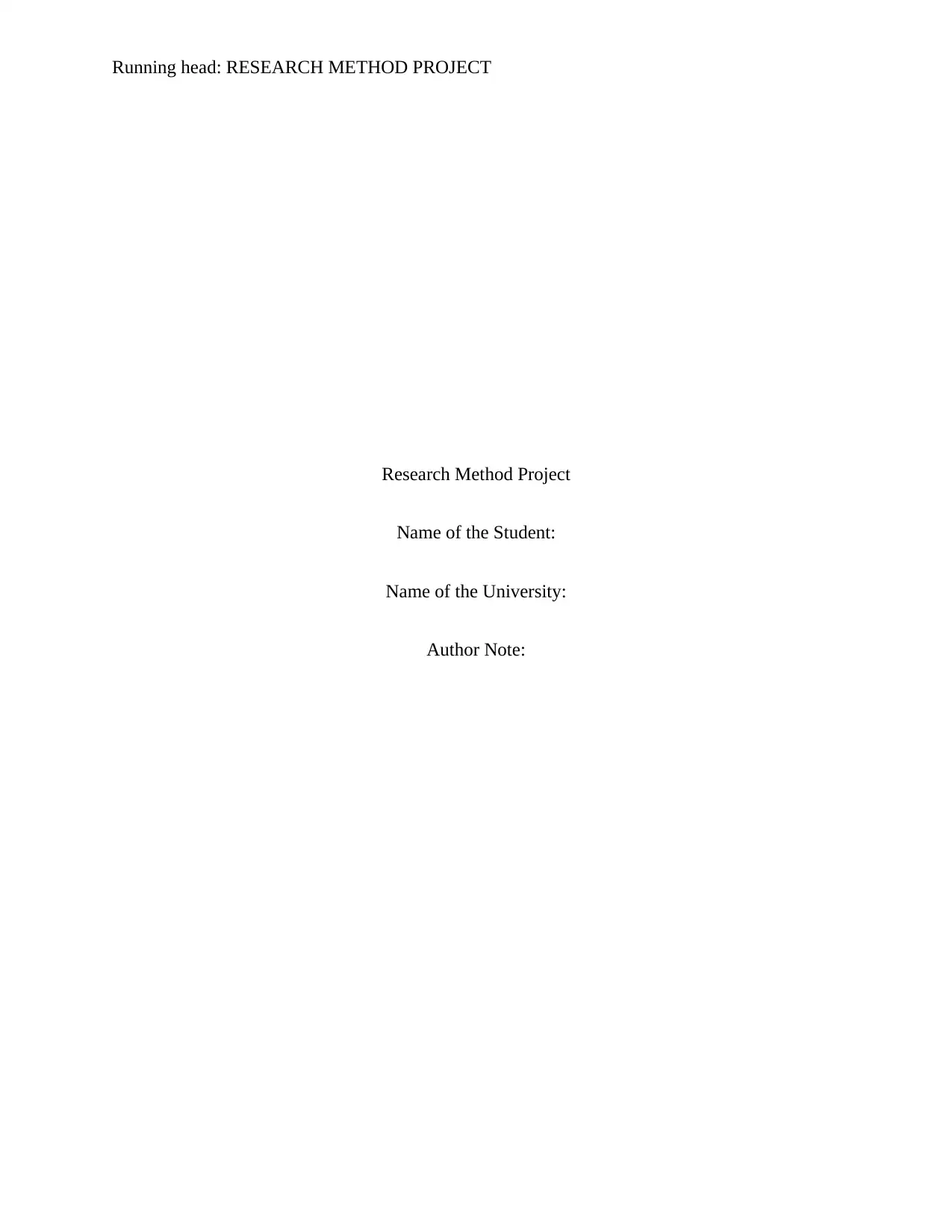
Running head: RESEARCH METHOD PROJECT
Research Method Project
Name of the Student:
Name of the University:
Author Note:
Research Method Project
Name of the Student:
Name of the University:
Author Note:
Secure Best Marks with AI Grader
Need help grading? Try our AI Grader for instant feedback on your assignments.
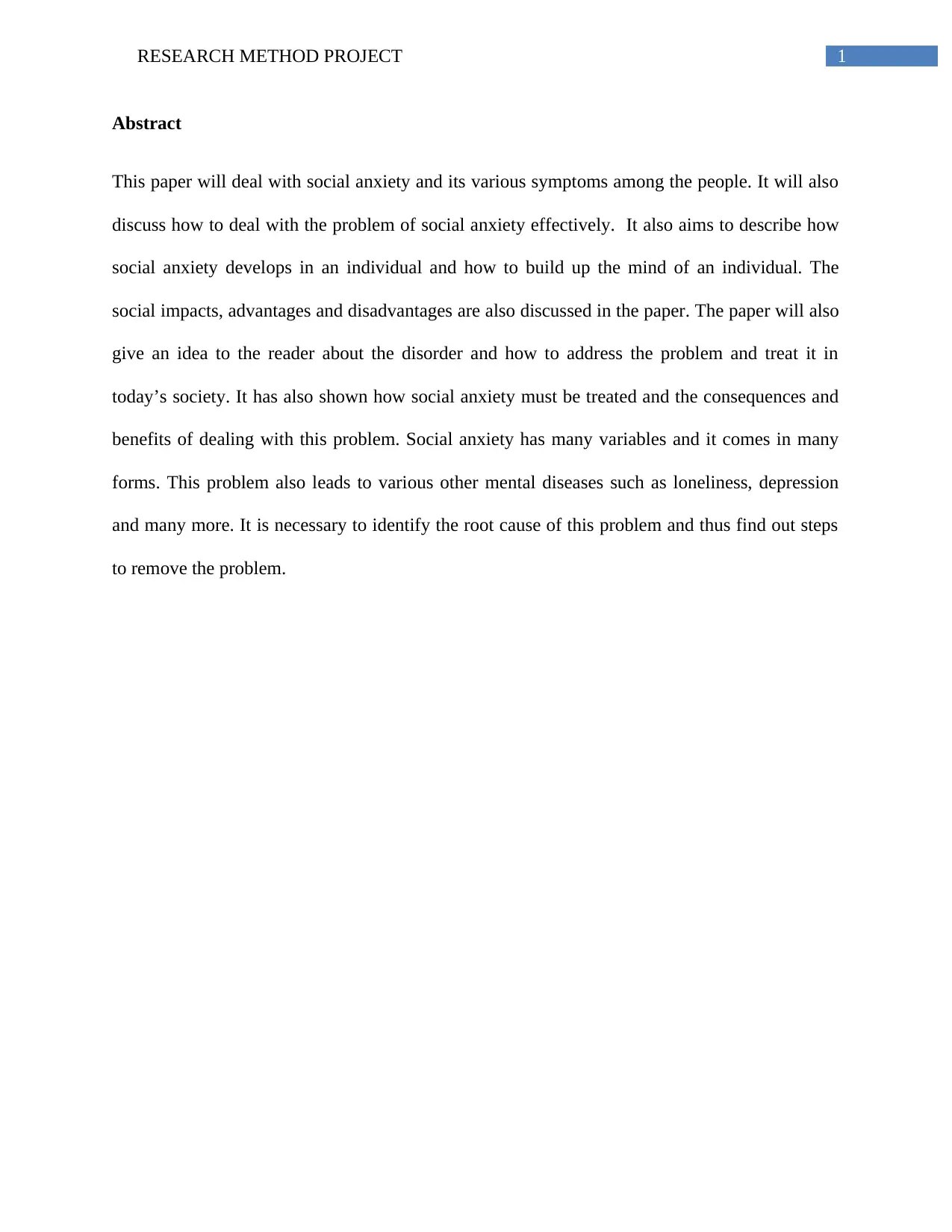
1RESEARCH METHOD PROJECT
Abstract
This paper will deal with social anxiety and its various symptoms among the people. It will also
discuss how to deal with the problem of social anxiety effectively. It also aims to describe how
social anxiety develops in an individual and how to build up the mind of an individual. The
social impacts, advantages and disadvantages are also discussed in the paper. The paper will also
give an idea to the reader about the disorder and how to address the problem and treat it in
today’s society. It has also shown how social anxiety must be treated and the consequences and
benefits of dealing with this problem. Social anxiety has many variables and it comes in many
forms. This problem also leads to various other mental diseases such as loneliness, depression
and many more. It is necessary to identify the root cause of this problem and thus find out steps
to remove the problem.
Abstract
This paper will deal with social anxiety and its various symptoms among the people. It will also
discuss how to deal with the problem of social anxiety effectively. It also aims to describe how
social anxiety develops in an individual and how to build up the mind of an individual. The
social impacts, advantages and disadvantages are also discussed in the paper. The paper will also
give an idea to the reader about the disorder and how to address the problem and treat it in
today’s society. It has also shown how social anxiety must be treated and the consequences and
benefits of dealing with this problem. Social anxiety has many variables and it comes in many
forms. This problem also leads to various other mental diseases such as loneliness, depression
and many more. It is necessary to identify the root cause of this problem and thus find out steps
to remove the problem.
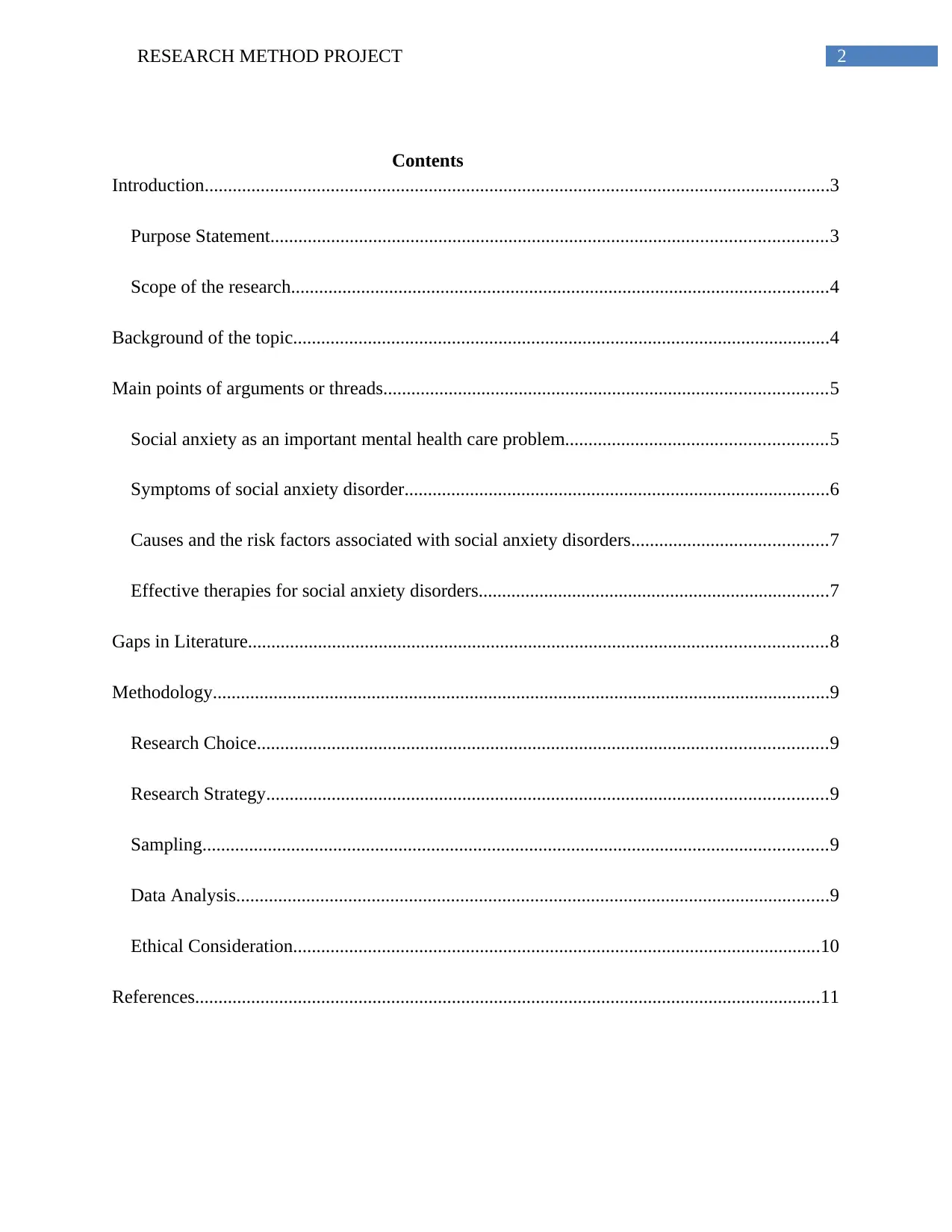
2RESEARCH METHOD PROJECT
Contents
Introduction......................................................................................................................................3
Purpose Statement.......................................................................................................................3
Scope of the research...................................................................................................................4
Background of the topic...................................................................................................................4
Main points of arguments or threads...............................................................................................5
Social anxiety as an important mental health care problem........................................................5
Symptoms of social anxiety disorder...........................................................................................6
Causes and the risk factors associated with social anxiety disorders..........................................7
Effective therapies for social anxiety disorders...........................................................................7
Gaps in Literature............................................................................................................................8
Methodology....................................................................................................................................9
Research Choice..........................................................................................................................9
Research Strategy........................................................................................................................9
Sampling......................................................................................................................................9
Data Analysis...............................................................................................................................9
Ethical Consideration.................................................................................................................10
References......................................................................................................................................11
Contents
Introduction......................................................................................................................................3
Purpose Statement.......................................................................................................................3
Scope of the research...................................................................................................................4
Background of the topic...................................................................................................................4
Main points of arguments or threads...............................................................................................5
Social anxiety as an important mental health care problem........................................................5
Symptoms of social anxiety disorder...........................................................................................6
Causes and the risk factors associated with social anxiety disorders..........................................7
Effective therapies for social anxiety disorders...........................................................................7
Gaps in Literature............................................................................................................................8
Methodology....................................................................................................................................9
Research Choice..........................................................................................................................9
Research Strategy........................................................................................................................9
Sampling......................................................................................................................................9
Data Analysis...............................................................................................................................9
Ethical Consideration.................................................................................................................10
References......................................................................................................................................11
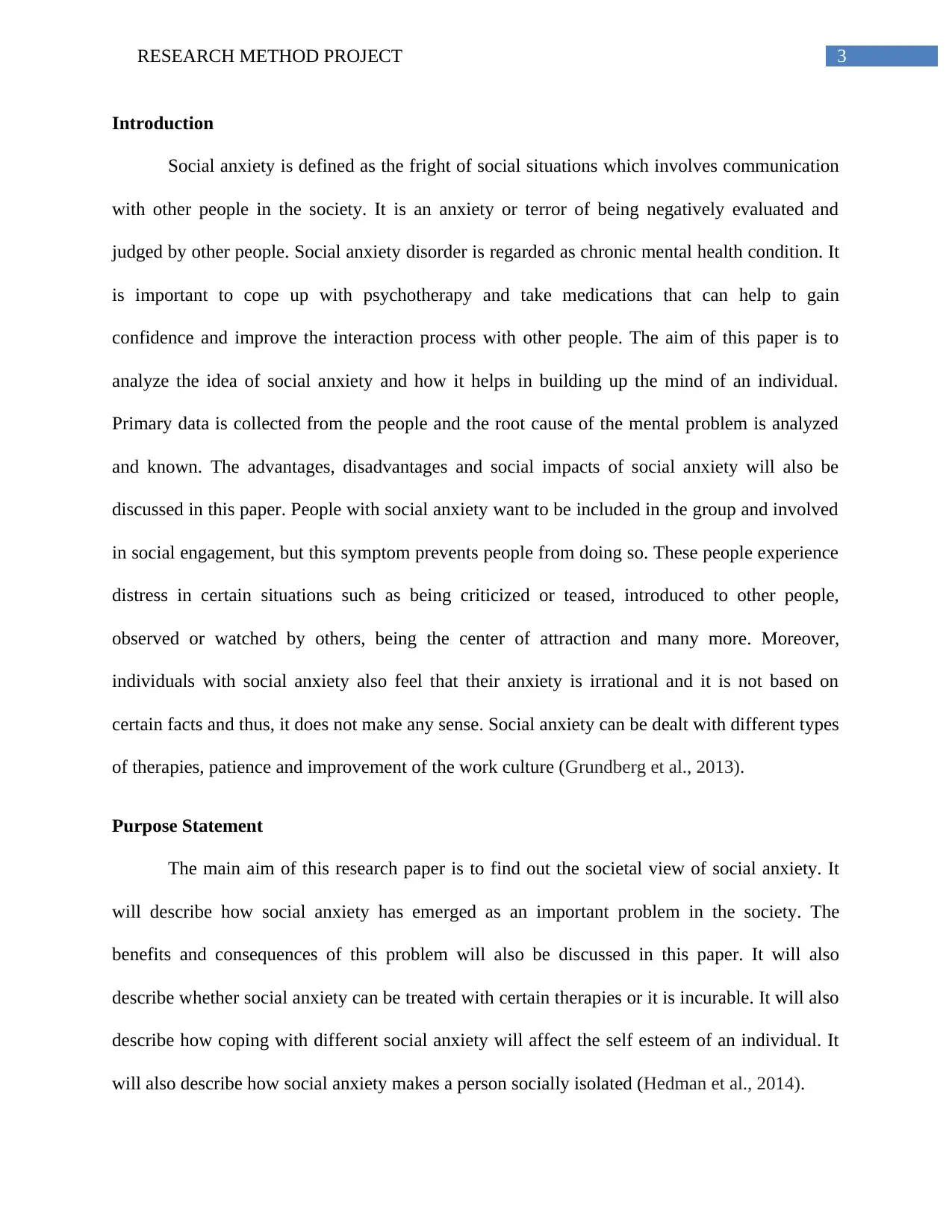
3RESEARCH METHOD PROJECT
Introduction
Social anxiety is defined as the fright of social situations which involves communication
with other people in the society. It is an anxiety or terror of being negatively evaluated and
judged by other people. Social anxiety disorder is regarded as chronic mental health condition. It
is important to cope up with psychotherapy and take medications that can help to gain
confidence and improve the interaction process with other people. The aim of this paper is to
analyze the idea of social anxiety and how it helps in building up the mind of an individual.
Primary data is collected from the people and the root cause of the mental problem is analyzed
and known. The advantages, disadvantages and social impacts of social anxiety will also be
discussed in this paper. People with social anxiety want to be included in the group and involved
in social engagement, but this symptom prevents people from doing so. These people experience
distress in certain situations such as being criticized or teased, introduced to other people,
observed or watched by others, being the center of attraction and many more. Moreover,
individuals with social anxiety also feel that their anxiety is irrational and it is not based on
certain facts and thus, it does not make any sense. Social anxiety can be dealt with different types
of therapies, patience and improvement of the work culture (Grundberg et al., 2013).
Purpose Statement
The main aim of this research paper is to find out the societal view of social anxiety. It
will describe how social anxiety has emerged as an important problem in the society. The
benefits and consequences of this problem will also be discussed in this paper. It will also
describe whether social anxiety can be treated with certain therapies or it is incurable. It will also
describe how coping with different social anxiety will affect the self esteem of an individual. It
will also describe how social anxiety makes a person socially isolated (Hedman et al., 2014).
Introduction
Social anxiety is defined as the fright of social situations which involves communication
with other people in the society. It is an anxiety or terror of being negatively evaluated and
judged by other people. Social anxiety disorder is regarded as chronic mental health condition. It
is important to cope up with psychotherapy and take medications that can help to gain
confidence and improve the interaction process with other people. The aim of this paper is to
analyze the idea of social anxiety and how it helps in building up the mind of an individual.
Primary data is collected from the people and the root cause of the mental problem is analyzed
and known. The advantages, disadvantages and social impacts of social anxiety will also be
discussed in this paper. People with social anxiety want to be included in the group and involved
in social engagement, but this symptom prevents people from doing so. These people experience
distress in certain situations such as being criticized or teased, introduced to other people,
observed or watched by others, being the center of attraction and many more. Moreover,
individuals with social anxiety also feel that their anxiety is irrational and it is not based on
certain facts and thus, it does not make any sense. Social anxiety can be dealt with different types
of therapies, patience and improvement of the work culture (Grundberg et al., 2013).
Purpose Statement
The main aim of this research paper is to find out the societal view of social anxiety. It
will describe how social anxiety has emerged as an important problem in the society. The
benefits and consequences of this problem will also be discussed in this paper. It will also
describe whether social anxiety can be treated with certain therapies or it is incurable. It will also
describe how coping with different social anxiety will affect the self esteem of an individual. It
will also describe how social anxiety makes a person socially isolated (Hedman et al., 2014).
Paraphrase This Document
Need a fresh take? Get an instant paraphrase of this document with our AI Paraphraser
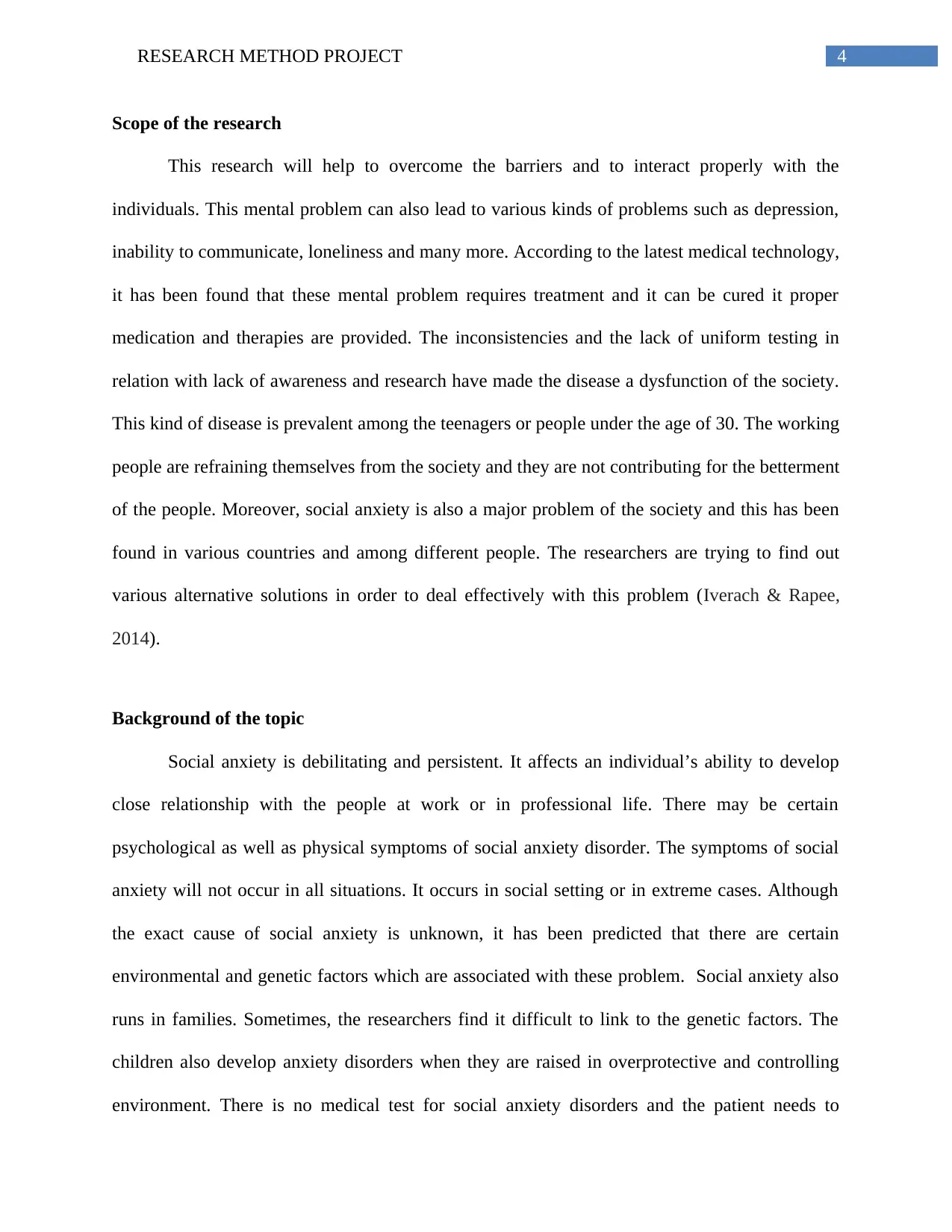
4RESEARCH METHOD PROJECT
Scope of the research
This research will help to overcome the barriers and to interact properly with the
individuals. This mental problem can also lead to various kinds of problems such as depression,
inability to communicate, loneliness and many more. According to the latest medical technology,
it has been found that these mental problem requires treatment and it can be cured it proper
medication and therapies are provided. The inconsistencies and the lack of uniform testing in
relation with lack of awareness and research have made the disease a dysfunction of the society.
This kind of disease is prevalent among the teenagers or people under the age of 30. The working
people are refraining themselves from the society and they are not contributing for the betterment
of the people. Moreover, social anxiety is also a major problem of the society and this has been
found in various countries and among different people. The researchers are trying to find out
various alternative solutions in order to deal effectively with this problem (Iverach & Rapee,
2014).
Background of the topic
Social anxiety is debilitating and persistent. It affects an individual’s ability to develop
close relationship with the people at work or in professional life. There may be certain
psychological as well as physical symptoms of social anxiety disorder. The symptoms of social
anxiety will not occur in all situations. It occurs in social setting or in extreme cases. Although
the exact cause of social anxiety is unknown, it has been predicted that there are certain
environmental and genetic factors which are associated with these problem. Social anxiety also
runs in families. Sometimes, the researchers find it difficult to link to the genetic factors. The
children also develop anxiety disorders when they are raised in overprotective and controlling
environment. There is no medical test for social anxiety disorders and the patient needs to
Scope of the research
This research will help to overcome the barriers and to interact properly with the
individuals. This mental problem can also lead to various kinds of problems such as depression,
inability to communicate, loneliness and many more. According to the latest medical technology,
it has been found that these mental problem requires treatment and it can be cured it proper
medication and therapies are provided. The inconsistencies and the lack of uniform testing in
relation with lack of awareness and research have made the disease a dysfunction of the society.
This kind of disease is prevalent among the teenagers or people under the age of 30. The working
people are refraining themselves from the society and they are not contributing for the betterment
of the people. Moreover, social anxiety is also a major problem of the society and this has been
found in various countries and among different people. The researchers are trying to find out
various alternative solutions in order to deal effectively with this problem (Iverach & Rapee,
2014).
Background of the topic
Social anxiety is debilitating and persistent. It affects an individual’s ability to develop
close relationship with the people at work or in professional life. There may be certain
psychological as well as physical symptoms of social anxiety disorder. The symptoms of social
anxiety will not occur in all situations. It occurs in social setting or in extreme cases. Although
the exact cause of social anxiety is unknown, it has been predicted that there are certain
environmental and genetic factors which are associated with these problem. Social anxiety also
runs in families. Sometimes, the researchers find it difficult to link to the genetic factors. The
children also develop anxiety disorders when they are raised in overprotective and controlling
environment. There is no medical test for social anxiety disorders and the patient needs to
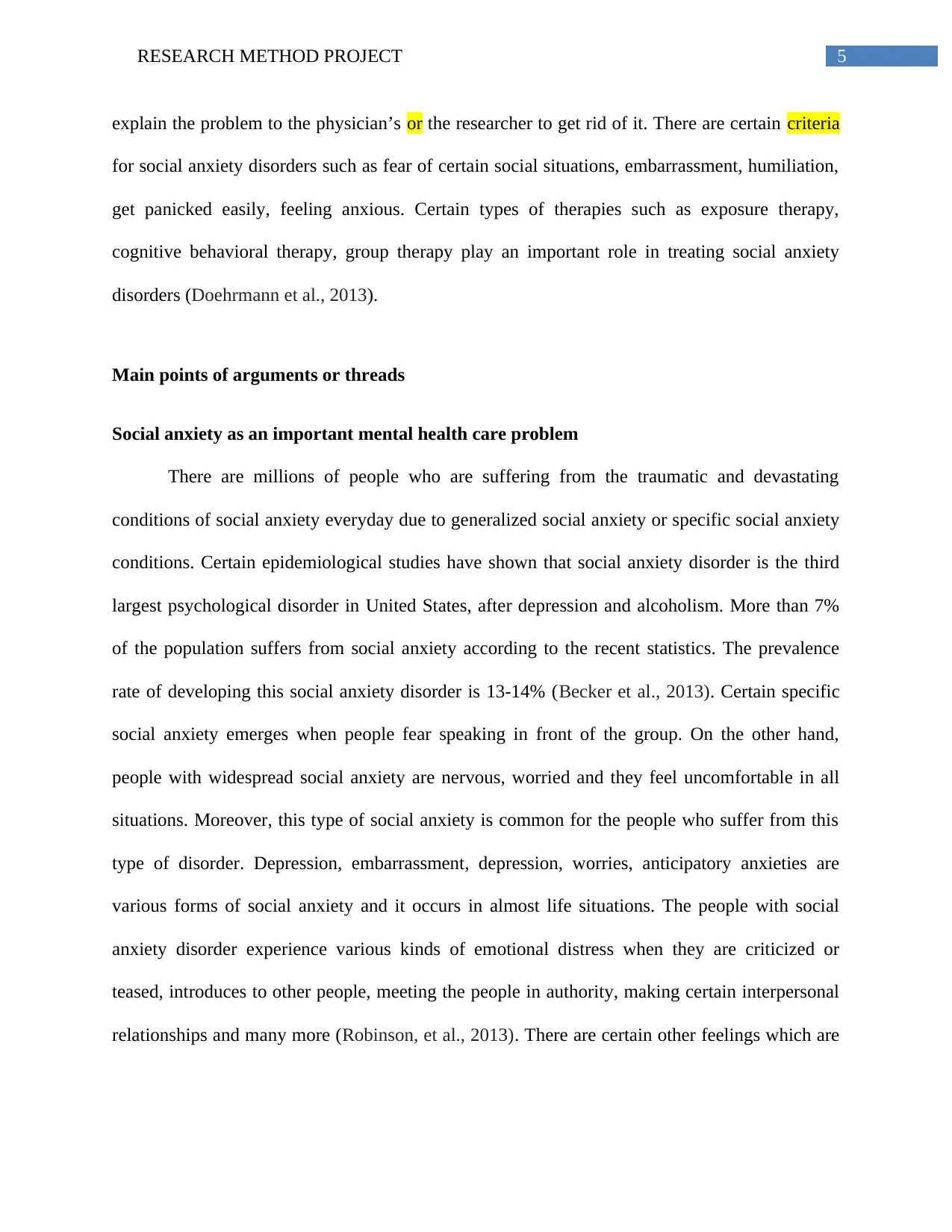
5RESEARCH METHOD PROJECT
explain the problem to the physician’s or the researcher to get rid of it. There are certain criteria
for social anxiety disorders such as fear of certain social situations, embarrassment, humiliation,
get panicked easily, feeling anxious. Certain types of therapies such as exposure therapy,
cognitive behavioral therapy, group therapy play an important role in treating social anxiety
disorders (Doehrmann et al., 2013).
Main points of arguments or threads
Social anxiety as an important mental health care problem
There are millions of people who are suffering from the traumatic and devastating
conditions of social anxiety everyday due to generalized social anxiety or specific social anxiety
conditions. Certain epidemiological studies have shown that social anxiety disorder is the third
largest psychological disorder in United States, after depression and alcoholism. More than 7%
of the population suffers from social anxiety according to the recent statistics. The prevalence
rate of developing this social anxiety disorder is 13-14% (Becker et al., 2013). Certain specific
social anxiety emerges when people fear speaking in front of the group. On the other hand,
people with widespread social anxiety are nervous, worried and they feel uncomfortable in all
situations. Moreover, this type of social anxiety is common for the people who suffer from this
type of disorder. Depression, embarrassment, depression, worries, anticipatory anxieties are
various forms of social anxiety and it occurs in almost life situations. The people with social
anxiety disorder experience various kinds of emotional distress when they are criticized or
teased, introduces to other people, meeting the people in authority, making certain interpersonal
relationships and many more (Robinson, et al., 2013). There are certain other feelings which are
explain the problem to the physician’s or the researcher to get rid of it. There are certain criteria
for social anxiety disorders such as fear of certain social situations, embarrassment, humiliation,
get panicked easily, feeling anxious. Certain types of therapies such as exposure therapy,
cognitive behavioral therapy, group therapy play an important role in treating social anxiety
disorders (Doehrmann et al., 2013).
Main points of arguments or threads
Social anxiety as an important mental health care problem
There are millions of people who are suffering from the traumatic and devastating
conditions of social anxiety everyday due to generalized social anxiety or specific social anxiety
conditions. Certain epidemiological studies have shown that social anxiety disorder is the third
largest psychological disorder in United States, after depression and alcoholism. More than 7%
of the population suffers from social anxiety according to the recent statistics. The prevalence
rate of developing this social anxiety disorder is 13-14% (Becker et al., 2013). Certain specific
social anxiety emerges when people fear speaking in front of the group. On the other hand,
people with widespread social anxiety are nervous, worried and they feel uncomfortable in all
situations. Moreover, this type of social anxiety is common for the people who suffer from this
type of disorder. Depression, embarrassment, depression, worries, anticipatory anxieties are
various forms of social anxiety and it occurs in almost life situations. The people with social
anxiety disorder experience various kinds of emotional distress when they are criticized or
teased, introduces to other people, meeting the people in authority, making certain interpersonal
relationships and many more (Robinson, et al., 2013). There are certain other feelings which are
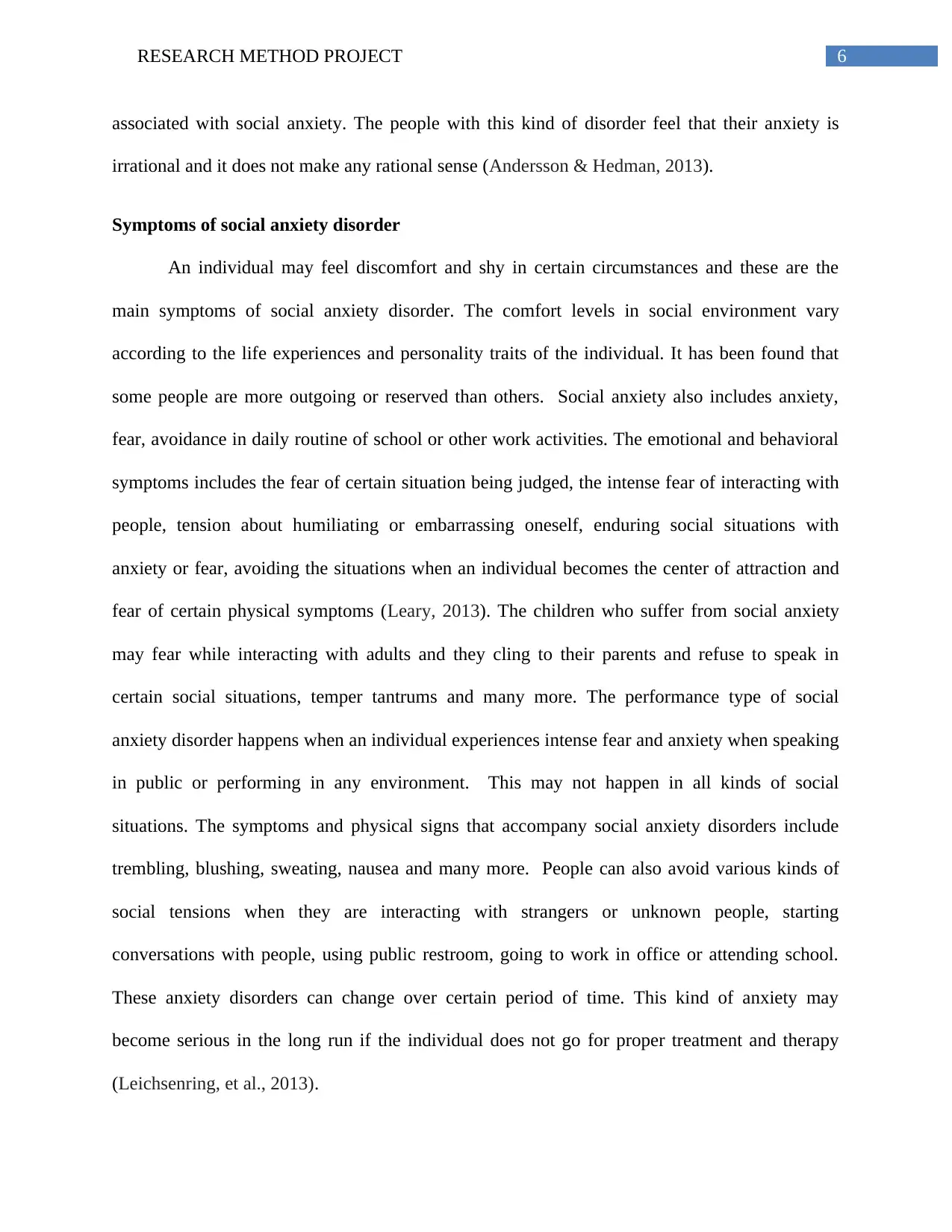
6RESEARCH METHOD PROJECT
associated with social anxiety. The people with this kind of disorder feel that their anxiety is
irrational and it does not make any rational sense (Andersson & Hedman, 2013).
Symptoms of social anxiety disorder
An individual may feel discomfort and shy in certain circumstances and these are the
main symptoms of social anxiety disorder. The comfort levels in social environment vary
according to the life experiences and personality traits of the individual. It has been found that
some people are more outgoing or reserved than others. Social anxiety also includes anxiety,
fear, avoidance in daily routine of school or other work activities. The emotional and behavioral
symptoms includes the fear of certain situation being judged, the intense fear of interacting with
people, tension about humiliating or embarrassing oneself, enduring social situations with
anxiety or fear, avoiding the situations when an individual becomes the center of attraction and
fear of certain physical symptoms (Leary, 2013). The children who suffer from social anxiety
may fear while interacting with adults and they cling to their parents and refuse to speak in
certain social situations, temper tantrums and many more. The performance type of social
anxiety disorder happens when an individual experiences intense fear and anxiety when speaking
in public or performing in any environment. This may not happen in all kinds of social
situations. The symptoms and physical signs that accompany social anxiety disorders include
trembling, blushing, sweating, nausea and many more. People can also avoid various kinds of
social tensions when they are interacting with strangers or unknown people, starting
conversations with people, using public restroom, going to work in office or attending school.
These anxiety disorders can change over certain period of time. This kind of anxiety may
become serious in the long run if the individual does not go for proper treatment and therapy
(Leichsenring, et al., 2013).
associated with social anxiety. The people with this kind of disorder feel that their anxiety is
irrational and it does not make any rational sense (Andersson & Hedman, 2013).
Symptoms of social anxiety disorder
An individual may feel discomfort and shy in certain circumstances and these are the
main symptoms of social anxiety disorder. The comfort levels in social environment vary
according to the life experiences and personality traits of the individual. It has been found that
some people are more outgoing or reserved than others. Social anxiety also includes anxiety,
fear, avoidance in daily routine of school or other work activities. The emotional and behavioral
symptoms includes the fear of certain situation being judged, the intense fear of interacting with
people, tension about humiliating or embarrassing oneself, enduring social situations with
anxiety or fear, avoiding the situations when an individual becomes the center of attraction and
fear of certain physical symptoms (Leary, 2013). The children who suffer from social anxiety
may fear while interacting with adults and they cling to their parents and refuse to speak in
certain social situations, temper tantrums and many more. The performance type of social
anxiety disorder happens when an individual experiences intense fear and anxiety when speaking
in public or performing in any environment. This may not happen in all kinds of social
situations. The symptoms and physical signs that accompany social anxiety disorders include
trembling, blushing, sweating, nausea and many more. People can also avoid various kinds of
social tensions when they are interacting with strangers or unknown people, starting
conversations with people, using public restroom, going to work in office or attending school.
These anxiety disorders can change over certain period of time. This kind of anxiety may
become serious in the long run if the individual does not go for proper treatment and therapy
(Leichsenring, et al., 2013).
Secure Best Marks with AI Grader
Need help grading? Try our AI Grader for instant feedback on your assignments.
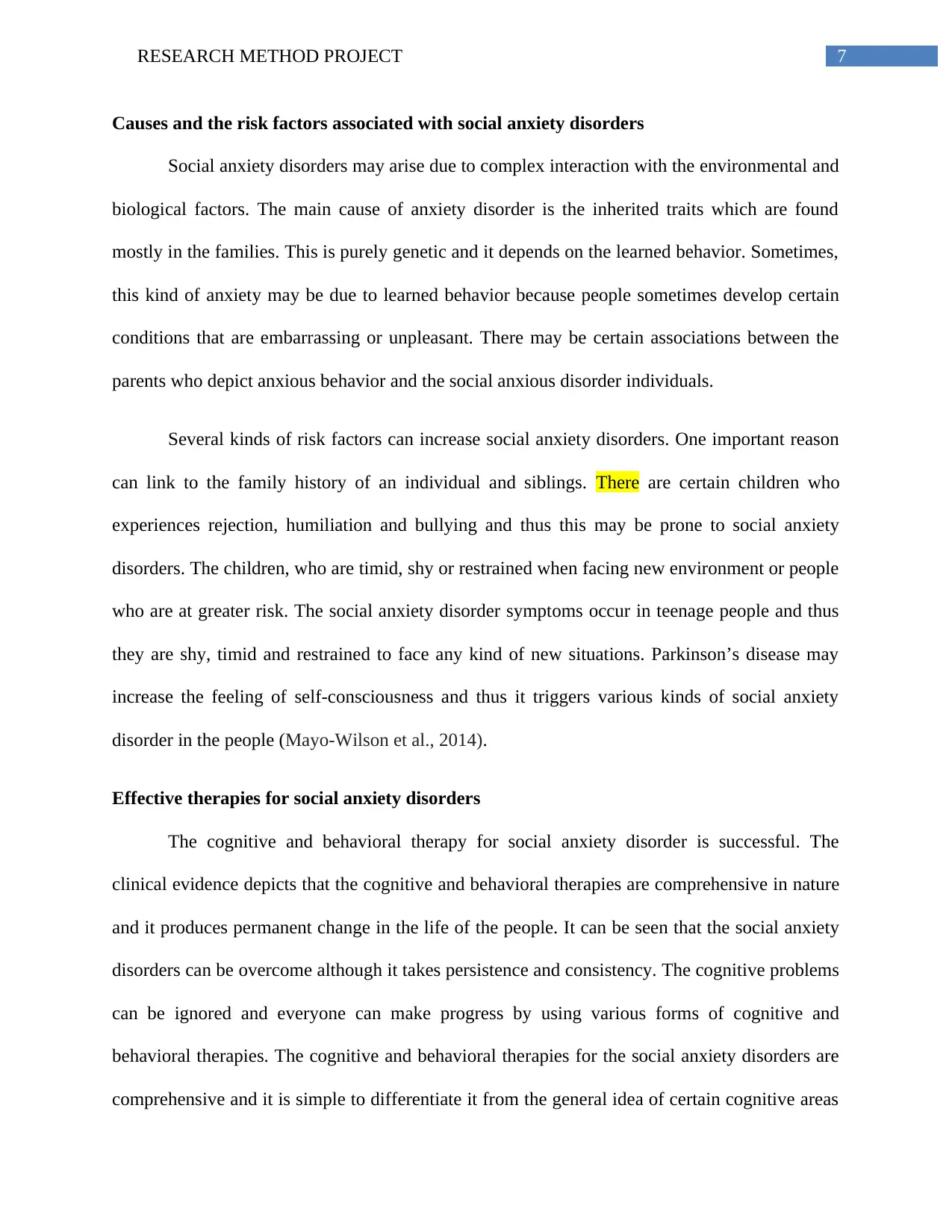
7RESEARCH METHOD PROJECT
Causes and the risk factors associated with social anxiety disorders
Social anxiety disorders may arise due to complex interaction with the environmental and
biological factors. The main cause of anxiety disorder is the inherited traits which are found
mostly in the families. This is purely genetic and it depends on the learned behavior. Sometimes,
this kind of anxiety may be due to learned behavior because people sometimes develop certain
conditions that are embarrassing or unpleasant. There may be certain associations between the
parents who depict anxious behavior and the social anxious disorder individuals.
Several kinds of risk factors can increase social anxiety disorders. One important reason
can link to the family history of an individual and siblings. There are certain children who
experiences rejection, humiliation and bullying and thus this may be prone to social anxiety
disorders. The children, who are timid, shy or restrained when facing new environment or people
who are at greater risk. The social anxiety disorder symptoms occur in teenage people and thus
they are shy, timid and restrained to face any kind of new situations. Parkinson’s disease may
increase the feeling of self-consciousness and thus it triggers various kinds of social anxiety
disorder in the people (Mayo-Wilson et al., 2014).
Effective therapies for social anxiety disorders
The cognitive and behavioral therapy for social anxiety disorder is successful. The
clinical evidence depicts that the cognitive and behavioral therapies are comprehensive in nature
and it produces permanent change in the life of the people. It can be seen that the social anxiety
disorders can be overcome although it takes persistence and consistency. The cognitive problems
can be ignored and everyone can make progress by using various forms of cognitive and
behavioral therapies. The cognitive and behavioral therapies for the social anxiety disorders are
comprehensive and it is simple to differentiate it from the general idea of certain cognitive areas
Causes and the risk factors associated with social anxiety disorders
Social anxiety disorders may arise due to complex interaction with the environmental and
biological factors. The main cause of anxiety disorder is the inherited traits which are found
mostly in the families. This is purely genetic and it depends on the learned behavior. Sometimes,
this kind of anxiety may be due to learned behavior because people sometimes develop certain
conditions that are embarrassing or unpleasant. There may be certain associations between the
parents who depict anxious behavior and the social anxious disorder individuals.
Several kinds of risk factors can increase social anxiety disorders. One important reason
can link to the family history of an individual and siblings. There are certain children who
experiences rejection, humiliation and bullying and thus this may be prone to social anxiety
disorders. The children, who are timid, shy or restrained when facing new environment or people
who are at greater risk. The social anxiety disorder symptoms occur in teenage people and thus
they are shy, timid and restrained to face any kind of new situations. Parkinson’s disease may
increase the feeling of self-consciousness and thus it triggers various kinds of social anxiety
disorder in the people (Mayo-Wilson et al., 2014).
Effective therapies for social anxiety disorders
The cognitive and behavioral therapy for social anxiety disorder is successful. The
clinical evidence depicts that the cognitive and behavioral therapies are comprehensive in nature
and it produces permanent change in the life of the people. It can be seen that the social anxiety
disorders can be overcome although it takes persistence and consistency. The cognitive problems
can be ignored and everyone can make progress by using various forms of cognitive and
behavioral therapies. The cognitive and behavioral therapies for the social anxiety disorders are
comprehensive and it is simple to differentiate it from the general idea of certain cognitive areas
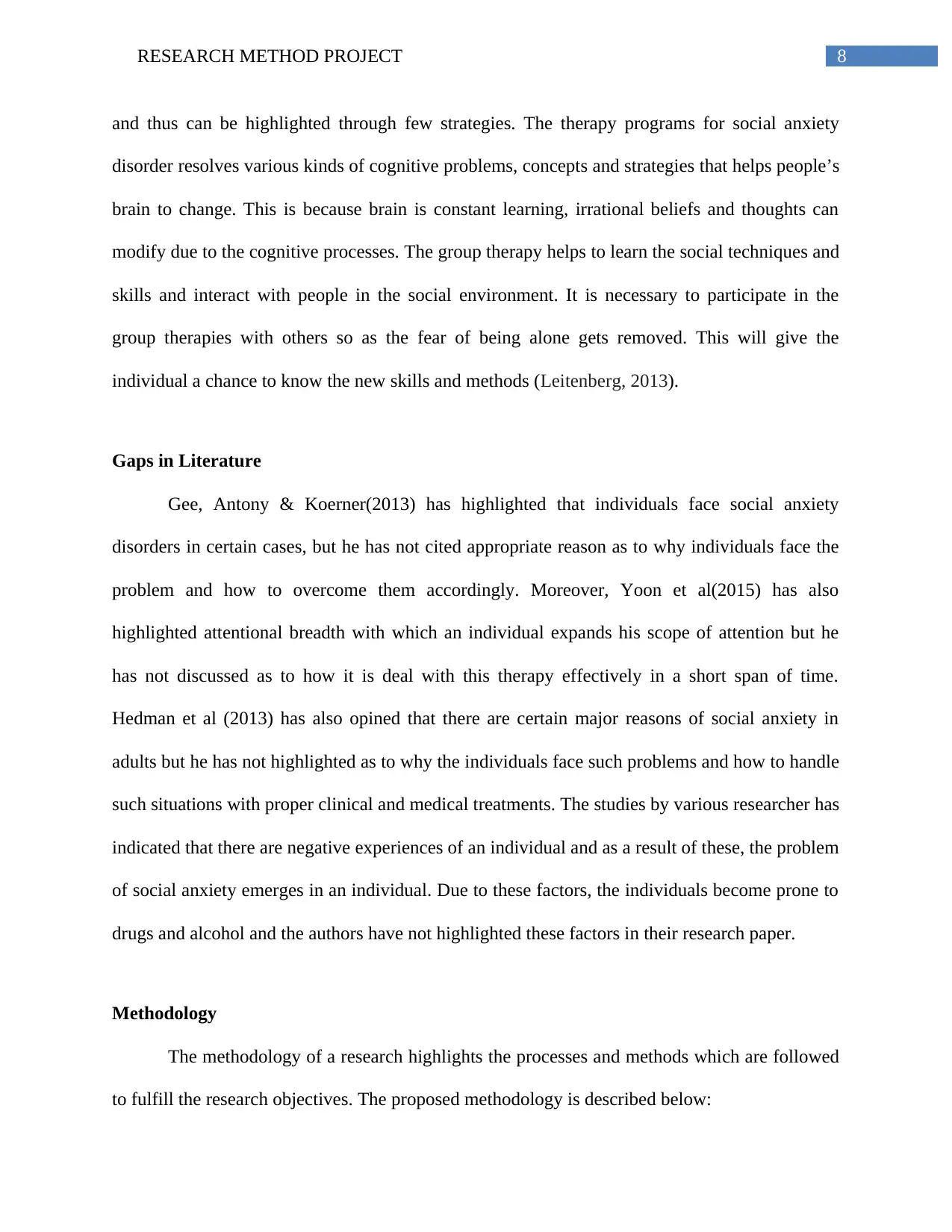
8RESEARCH METHOD PROJECT
and thus can be highlighted through few strategies. The therapy programs for social anxiety
disorder resolves various kinds of cognitive problems, concepts and strategies that helps people’s
brain to change. This is because brain is constant learning, irrational beliefs and thoughts can
modify due to the cognitive processes. The group therapy helps to learn the social techniques and
skills and interact with people in the social environment. It is necessary to participate in the
group therapies with others so as the fear of being alone gets removed. This will give the
individual a chance to know the new skills and methods (Leitenberg, 2013).
Gaps in Literature
Gee, Antony & Koerner(2013) has highlighted that individuals face social anxiety
disorders in certain cases, but he has not cited appropriate reason as to why individuals face the
problem and how to overcome them accordingly. Moreover, Yoon et al(2015) has also
highlighted attentional breadth with which an individual expands his scope of attention but he
has not discussed as to how it is deal with this therapy effectively in a short span of time.
Hedman et al (2013) has also opined that there are certain major reasons of social anxiety in
adults but he has not highlighted as to why the individuals face such problems and how to handle
such situations with proper clinical and medical treatments. The studies by various researcher has
indicated that there are negative experiences of an individual and as a result of these, the problem
of social anxiety emerges in an individual. Due to these factors, the individuals become prone to
drugs and alcohol and the authors have not highlighted these factors in their research paper.
Methodology
The methodology of a research highlights the processes and methods which are followed
to fulfill the research objectives. The proposed methodology is described below:
and thus can be highlighted through few strategies. The therapy programs for social anxiety
disorder resolves various kinds of cognitive problems, concepts and strategies that helps people’s
brain to change. This is because brain is constant learning, irrational beliefs and thoughts can
modify due to the cognitive processes. The group therapy helps to learn the social techniques and
skills and interact with people in the social environment. It is necessary to participate in the
group therapies with others so as the fear of being alone gets removed. This will give the
individual a chance to know the new skills and methods (Leitenberg, 2013).
Gaps in Literature
Gee, Antony & Koerner(2013) has highlighted that individuals face social anxiety
disorders in certain cases, but he has not cited appropriate reason as to why individuals face the
problem and how to overcome them accordingly. Moreover, Yoon et al(2015) has also
highlighted attentional breadth with which an individual expands his scope of attention but he
has not discussed as to how it is deal with this therapy effectively in a short span of time.
Hedman et al (2013) has also opined that there are certain major reasons of social anxiety in
adults but he has not highlighted as to why the individuals face such problems and how to handle
such situations with proper clinical and medical treatments. The studies by various researcher has
indicated that there are negative experiences of an individual and as a result of these, the problem
of social anxiety emerges in an individual. Due to these factors, the individuals become prone to
drugs and alcohol and the authors have not highlighted these factors in their research paper.
Methodology
The methodology of a research highlights the processes and methods which are followed
to fulfill the research objectives. The proposed methodology is described below:

9RESEARCH METHOD PROJECT
Research Choice
In this research, quantitative data will be used will be used to conduct the study. The
choice of quantitative data will help to find the correlation between the variables such as social
anxiety, hypertension, teenagers and many more. The choice of using quantitative data will help
to meet the research objectives.
Research Strategy
Based on the nature of source, research can be primary or secondary. For this case,
primary data has been collected from the parents or guardians of the individuals who are
suffering from social anxiety. This has provided direct response from the individuals regarding
social anxiety.
Sampling
The process of sampling will help to select the participants from the targeted population.
The target population is the people who are residing in particular locality in Australia who are
suffering from social anxiety. This will help to keep the sample group homogenized as possible
and reduce the biasness of the research.
Data Analysis
The data will be analyzed through various statistical tools such as SPSS. This will assist
to find out the association between the dependent and the independent variables.
Ethical Consideration
It is essential to ensure reliability and validity in the research work. It must also be
ensured that the individuals must not be forced to give up the information. Moreover, the
Research Choice
In this research, quantitative data will be used will be used to conduct the study. The
choice of quantitative data will help to find the correlation between the variables such as social
anxiety, hypertension, teenagers and many more. The choice of using quantitative data will help
to meet the research objectives.
Research Strategy
Based on the nature of source, research can be primary or secondary. For this case,
primary data has been collected from the parents or guardians of the individuals who are
suffering from social anxiety. This has provided direct response from the individuals regarding
social anxiety.
Sampling
The process of sampling will help to select the participants from the targeted population.
The target population is the people who are residing in particular locality in Australia who are
suffering from social anxiety. This will help to keep the sample group homogenized as possible
and reduce the biasness of the research.
Data Analysis
The data will be analyzed through various statistical tools such as SPSS. This will assist
to find out the association between the dependent and the independent variables.
Ethical Consideration
It is essential to ensure reliability and validity in the research work. It must also be
ensured that the individuals must not be forced to give up the information. Moreover, the
Paraphrase This Document
Need a fresh take? Get an instant paraphrase of this document with our AI Paraphraser

10RESEARCH METHOD PROJECT
purpose of gathering the data must also be fully disclosed to them. This will help to meet the
desired research objectives (Bryman & Bell, 2015).
purpose of gathering the data must also be fully disclosed to them. This will help to meet the
desired research objectives (Bryman & Bell, 2015).
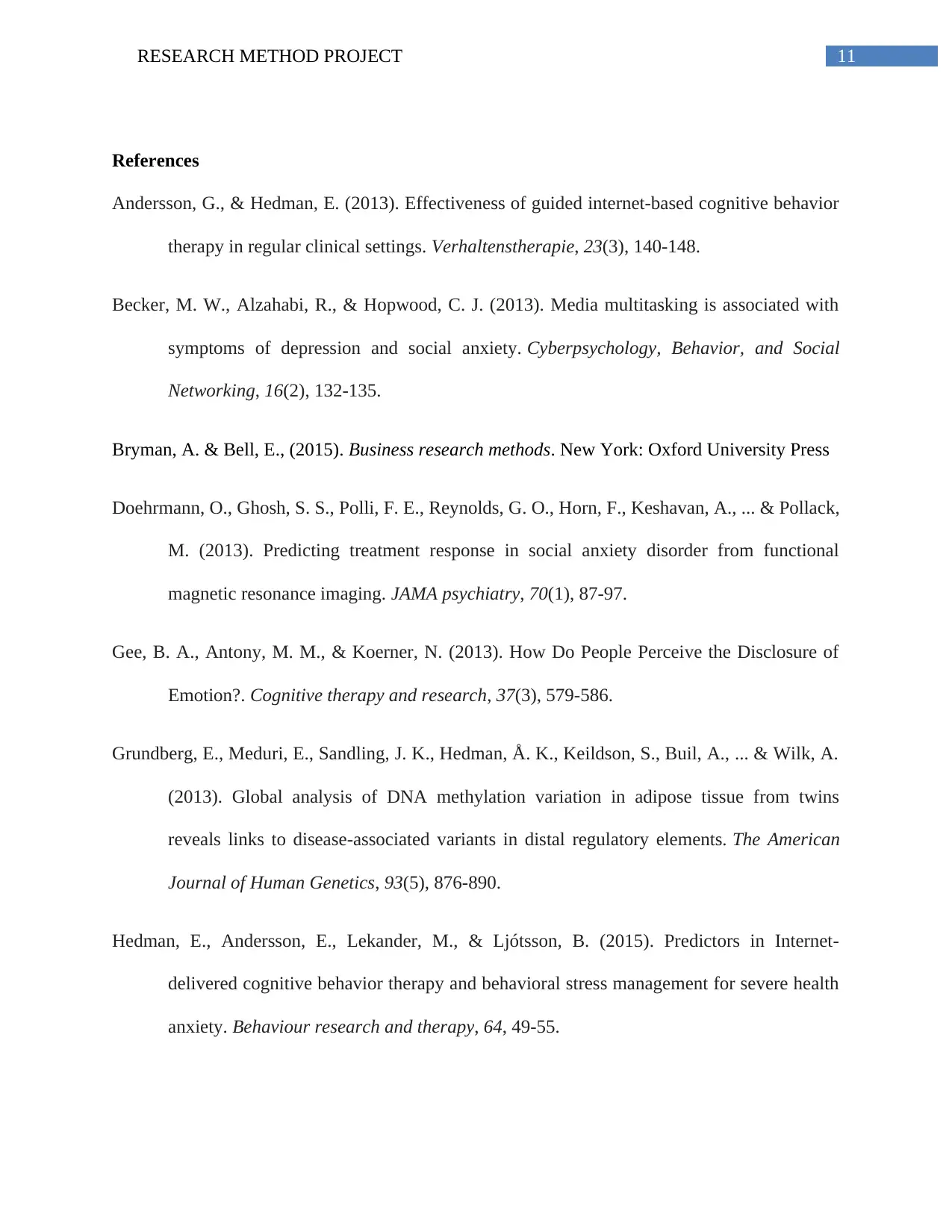
11RESEARCH METHOD PROJECT
References
Andersson, G., & Hedman, E. (2013). Effectiveness of guided internet-based cognitive behavior
therapy in regular clinical settings. Verhaltenstherapie, 23(3), 140-148.
Becker, M. W., Alzahabi, R., & Hopwood, C. J. (2013). Media multitasking is associated with
symptoms of depression and social anxiety. Cyberpsychology, Behavior, and Social
Networking, 16(2), 132-135.
Bryman, A. & Bell, E., (2015). Business research methods. New York: Oxford University Press
Doehrmann, O., Ghosh, S. S., Polli, F. E., Reynolds, G. O., Horn, F., Keshavan, A., ... & Pollack,
M. (2013). Predicting treatment response in social anxiety disorder from functional
magnetic resonance imaging. JAMA psychiatry, 70(1), 87-97.
Gee, B. A., Antony, M. M., & Koerner, N. (2013). How Do People Perceive the Disclosure of
Emotion?. Cognitive therapy and research, 37(3), 579-586.
Grundberg, E., Meduri, E., Sandling, J. K., Hedman, Å. K., Keildson, S., Buil, A., ... & Wilk, A.
(2013). Global analysis of DNA methylation variation in adipose tissue from twins
reveals links to disease-associated variants in distal regulatory elements. The American
Journal of Human Genetics, 93(5), 876-890.
Hedman, E., Andersson, E., Lekander, M., & Ljótsson, B. (2015). Predictors in Internet-
delivered cognitive behavior therapy and behavioral stress management for severe health
anxiety. Behaviour research and therapy, 64, 49-55.
References
Andersson, G., & Hedman, E. (2013). Effectiveness of guided internet-based cognitive behavior
therapy in regular clinical settings. Verhaltenstherapie, 23(3), 140-148.
Becker, M. W., Alzahabi, R., & Hopwood, C. J. (2013). Media multitasking is associated with
symptoms of depression and social anxiety. Cyberpsychology, Behavior, and Social
Networking, 16(2), 132-135.
Bryman, A. & Bell, E., (2015). Business research methods. New York: Oxford University Press
Doehrmann, O., Ghosh, S. S., Polli, F. E., Reynolds, G. O., Horn, F., Keshavan, A., ... & Pollack,
M. (2013). Predicting treatment response in social anxiety disorder from functional
magnetic resonance imaging. JAMA psychiatry, 70(1), 87-97.
Gee, B. A., Antony, M. M., & Koerner, N. (2013). How Do People Perceive the Disclosure of
Emotion?. Cognitive therapy and research, 37(3), 579-586.
Grundberg, E., Meduri, E., Sandling, J. K., Hedman, Å. K., Keildson, S., Buil, A., ... & Wilk, A.
(2013). Global analysis of DNA methylation variation in adipose tissue from twins
reveals links to disease-associated variants in distal regulatory elements. The American
Journal of Human Genetics, 93(5), 876-890.
Hedman, E., Andersson, E., Lekander, M., & Ljótsson, B. (2015). Predictors in Internet-
delivered cognitive behavior therapy and behavioral stress management for severe health
anxiety. Behaviour research and therapy, 64, 49-55.
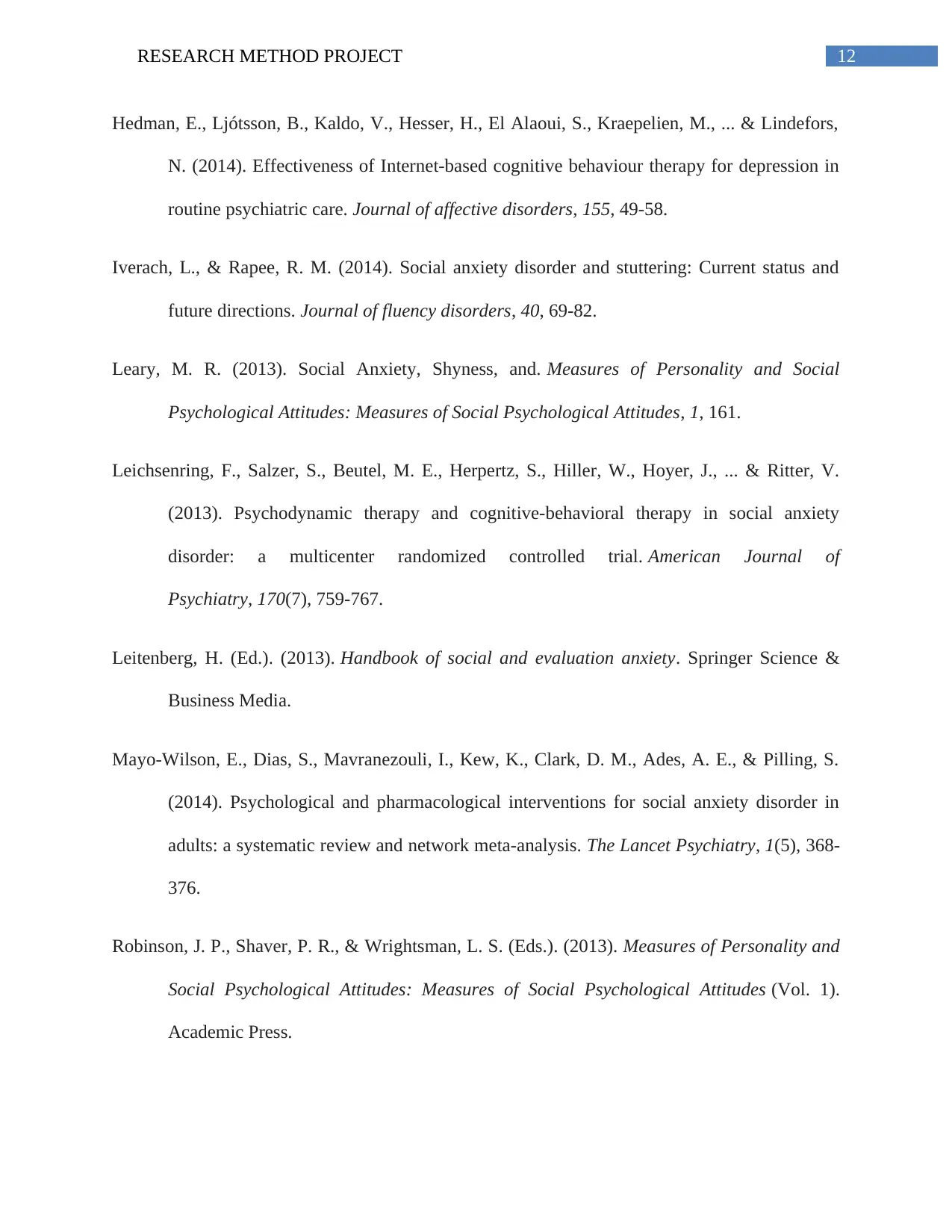
12RESEARCH METHOD PROJECT
Hedman, E., Ljótsson, B., Kaldo, V., Hesser, H., El Alaoui, S., Kraepelien, M., ... & Lindefors,
N. (2014). Effectiveness of Internet-based cognitive behaviour therapy for depression in
routine psychiatric care. Journal of affective disorders, 155, 49-58.
Iverach, L., & Rapee, R. M. (2014). Social anxiety disorder and stuttering: Current status and
future directions. Journal of fluency disorders, 40, 69-82.
Leary, M. R. (2013). Social Anxiety, Shyness, and. Measures of Personality and Social
Psychological Attitudes: Measures of Social Psychological Attitudes, 1, 161.
Leichsenring, F., Salzer, S., Beutel, M. E., Herpertz, S., Hiller, W., Hoyer, J., ... & Ritter, V.
(2013). Psychodynamic therapy and cognitive-behavioral therapy in social anxiety
disorder: a multicenter randomized controlled trial. American Journal of
Psychiatry, 170(7), 759-767.
Leitenberg, H. (Ed.). (2013). Handbook of social and evaluation anxiety. Springer Science &
Business Media.
Mayo-Wilson, E., Dias, S., Mavranezouli, I., Kew, K., Clark, D. M., Ades, A. E., & Pilling, S.
(2014). Psychological and pharmacological interventions for social anxiety disorder in
adults: a systematic review and network meta-analysis. The Lancet Psychiatry, 1(5), 368-
376.
Robinson, J. P., Shaver, P. R., & Wrightsman, L. S. (Eds.). (2013). Measures of Personality and
Social Psychological Attitudes: Measures of Social Psychological Attitudes (Vol. 1).
Academic Press.
Hedman, E., Ljótsson, B., Kaldo, V., Hesser, H., El Alaoui, S., Kraepelien, M., ... & Lindefors,
N. (2014). Effectiveness of Internet-based cognitive behaviour therapy for depression in
routine psychiatric care. Journal of affective disorders, 155, 49-58.
Iverach, L., & Rapee, R. M. (2014). Social anxiety disorder and stuttering: Current status and
future directions. Journal of fluency disorders, 40, 69-82.
Leary, M. R. (2013). Social Anxiety, Shyness, and. Measures of Personality and Social
Psychological Attitudes: Measures of Social Psychological Attitudes, 1, 161.
Leichsenring, F., Salzer, S., Beutel, M. E., Herpertz, S., Hiller, W., Hoyer, J., ... & Ritter, V.
(2013). Psychodynamic therapy and cognitive-behavioral therapy in social anxiety
disorder: a multicenter randomized controlled trial. American Journal of
Psychiatry, 170(7), 759-767.
Leitenberg, H. (Ed.). (2013). Handbook of social and evaluation anxiety. Springer Science &
Business Media.
Mayo-Wilson, E., Dias, S., Mavranezouli, I., Kew, K., Clark, D. M., Ades, A. E., & Pilling, S.
(2014). Psychological and pharmacological interventions for social anxiety disorder in
adults: a systematic review and network meta-analysis. The Lancet Psychiatry, 1(5), 368-
376.
Robinson, J. P., Shaver, P. R., & Wrightsman, L. S. (Eds.). (2013). Measures of Personality and
Social Psychological Attitudes: Measures of Social Psychological Attitudes (Vol. 1).
Academic Press.
Secure Best Marks with AI Grader
Need help grading? Try our AI Grader for instant feedback on your assignments.

13RESEARCH METHOD PROJECT
Yoon, K. L., Vidaurri, D. N., Joormann, J., & De Raedt, R. (2015). Social anxiety and narrowed
attentional breadth toward faces. Emotion, 15(6), 682.
Yoon, K. L., Vidaurri, D. N., Joormann, J., & De Raedt, R. (2015). Social anxiety and narrowed
attentional breadth toward faces. Emotion, 15(6), 682.
1 out of 14
Related Documents
Your All-in-One AI-Powered Toolkit for Academic Success.
+13062052269
info@desklib.com
Available 24*7 on WhatsApp / Email
![[object Object]](/_next/static/media/star-bottom.7253800d.svg)
Unlock your academic potential
© 2024 | Zucol Services PVT LTD | All rights reserved.




